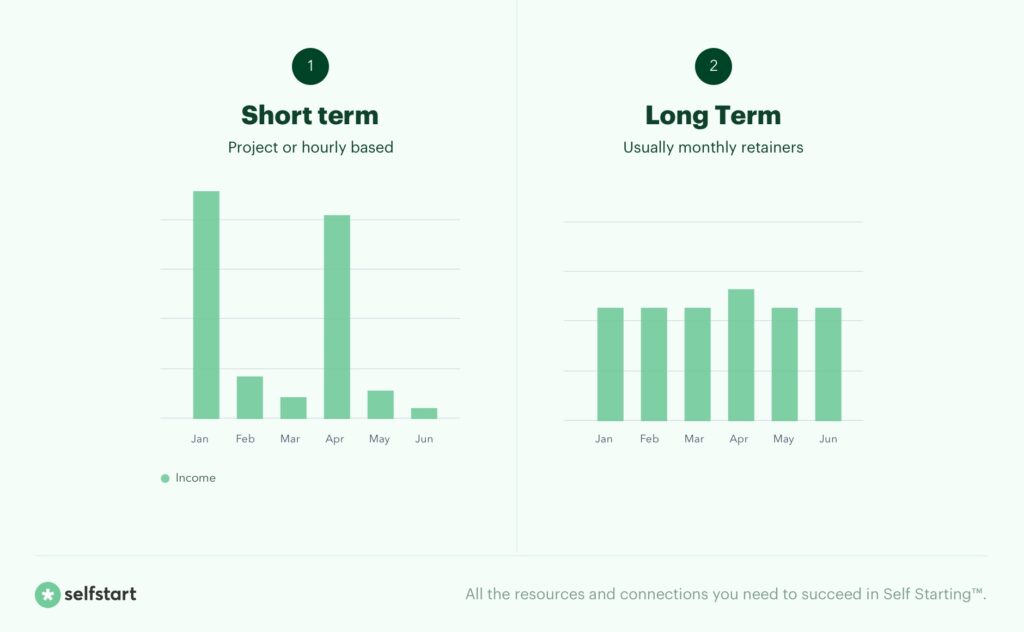Getting a pay raise as a freelancer looks a lot different than working for someone else. It’s not just a matter of getting a nice performance review and hitting your boss up for an increase. If you want more money as a freelancer, you either have to acquire more clients or charge more for your services, both of which pose unique challenges.
Given the fact that you have a finite amount of time, there are only so many clients you can take on before you’re maxed out. And if you raise your prices too much, you risk alienating the ones you already have with no guarantee you’ll attract new ones.
Still, that doesn’t mean you can’t increase your earnings. All you need is a little strategy and creativity. Here are five powerful ways to give yourself a raise without increasing your working hours or raising your prices:
1. Offer Retainer Projects
The typical freelancing model consists of trading time for dollars. Or in other words, you only get paid for the amount of time you work. However, you could expand your services (and profits) by keeping clients on a retainer. This makes your business less transactional and more of a relationship between you and your clients.
By definition, a retainer is a monthly fee that a client pays in order to have access to your services. Lawyers typically work on retainer because businesses or individuals never know when they’re going to need legal services. By paying a retainer, they remain on the lawyer’s radar so that when they do need something, they’re not put on a waiting list or turned away.
Freelancers can put the same model to work to increase their services and profits. For example, let’s say you usually charge $100 an hour for your services. But if you wanted to go the route of a retainer, you could sell a client 10 hours of your services for $800 a month. This fee stays the same even if you don’t work the full 10 hours per month.

You’re basically selling your future availability for a fixed monthly price. It’s guaranteed income for you, even if you’re not working that full set of hours each month. Plus, it gives clients the confidence that you’ll be available to help them when they need you.
2. Outsource to Other Freelancers
One thing freelancers do to buy more time freedom is to pass off some of their projects to other freelancers and take a cut. You might not be making as much per project, but you’re also doing just a fraction of the work than you would have been.
This allows you to take on a larger client load and may even justify charging more for your services. Or, it can help free up your time to go on a paid vacation or even bank a few sick days without worrying about the loss of revenue.
Platforms like Fiverr and Upwork are excellent places to meet other freelancers, even if you are not selling your own services there. You can also connect with other freelancers via LinkedIn or other social media channels if you prefer to work with them directly.
3. Charge by the Project
Once you’ve been freelancing for a while, you’ll gain a better idea of how long it takes you to complete certain projects or tasks. This is an excellent opportunity to switch from charging by the hour to charging by the project. Base your rates on how long you estimate a project will take so that you’re making what you want to make per hour.
If you end up completing the project in less time, then you’ve made a little extra money and freed up a little more time in the process. This model can also motivate you to work as quickly and efficiently as possible, as long as you’re not cutting corners on quality.
It’s also usually better for the client because they know exactly how much a certain project is going to cost them. Many clients prefer this model so that they can properly budget on their end.
If you decide to follow this model, make sure you specify what’s included in the price of the project. For example, you might allocate one 15-minute conference call or one request for revisions, and any additional requests outside of that will incur additional charges. This helps you better manage your time and costs so that you don’t end up making less per hour than what you had planned.
4. Narrow Your Focus
One of the biggest mistakes new freelancers make is offering too many options and too many services. This can be detrimental to your profits because it takes more brainpower to be able to do multiple things at an expert level.
When you narrow your focus to just one or two specific services, you may find that efficiency increases automatically. You discover shortcuts in your work without sacrificing quality. It’s easier to build systems and processes for a few things than it is to encompass several different services.
As a result, you’ll free up more time and can take on additional projects, which means more income.
5. Pay Attention to Your Most Profitable Projects
If you’ve done a good job of tracking your sales, you should be able to identify which ones are the most profitable. There are two components to this: measuring the amount of time a project took and how much money it brought in.
By knowing which projects took the least amount of time AND made the most money, you can shift your service offerings to focus on more of those types of projects. I highly recommend using data to make these decisions rather than gut instincts, as data will give you the most direct and accurate insight.
Working for yourself means also finding ways to give yourself a raise when you need (or want) it most. For more entrepreneurial insights, head back to my blog.
Wrapping It Up
To conclude, look at how you can build relationships with your current client base and also as you do any sort of outreach to get new clients. This is key to sustaining longer-term projects and being able to have anywhere between 3-5 consistent clients at a time.
Here’s some advice I 100% agree with by SelfStart:
- Repetitiveness – Can you find clients that will need your services more than once, and ideally in high frequency?
- Long-term Value – Have you found a way to increase your value offering over time? Is there a specific advantage to you working with a client for more than 4-5 months as opposed to once-off?
- Demand – Are the services that you are offering in high demand? If not, can you shape them and make them a bit more unique so that they are? Another way to do this is to target a niche market, where finding the services that you offer is harder.





